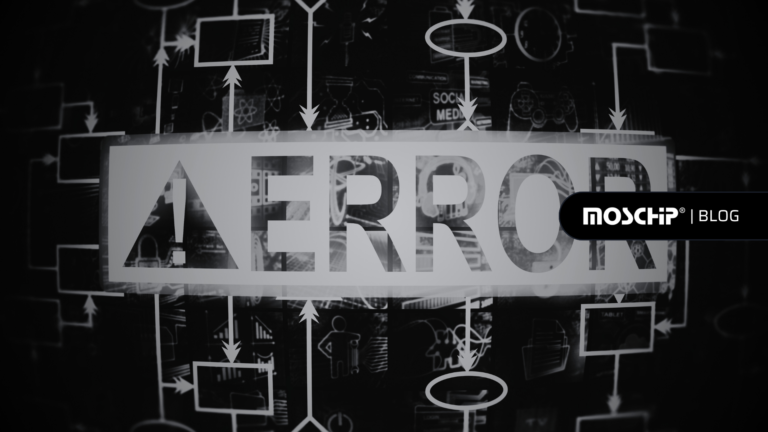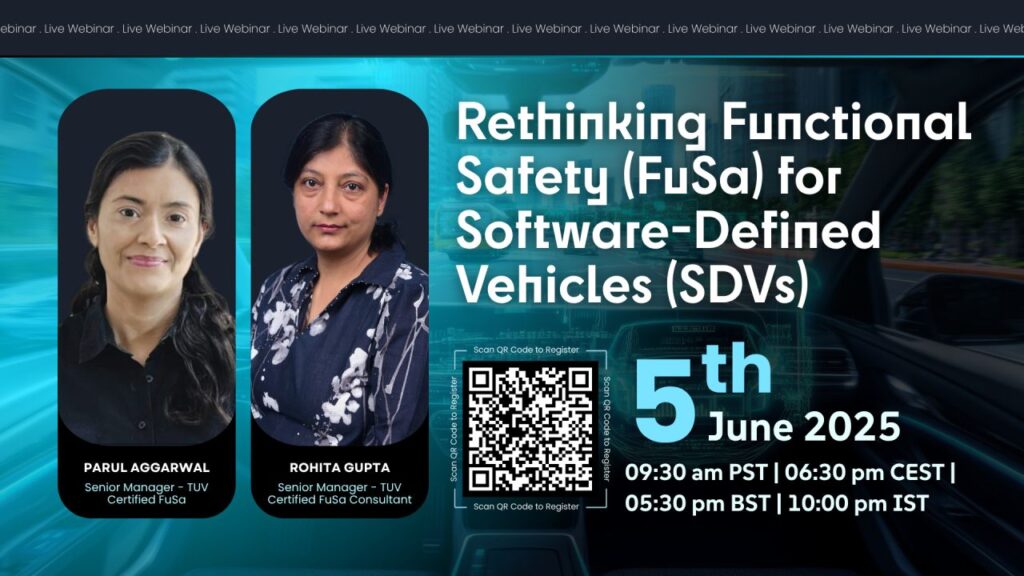The Future of Functional Safety in the Era of Software-Defined Vehicles – PoV
As automotive design rapidly evolves from hardware-centric machines to software-driven ecosystems, ensuring Functional Safety (FuSa) becomes critical to innovation. Software-defined vehicles (SDVs) enable dynamic updates, cloud integration, and autonomy, but with these capabilities come increased risks.
In this article, Parul Aggarwal, Senior Manager – Media Engineering, delves into the evolving landscape of Functional Safety in Software-Defined Vehicles. The shift to software-first platforms in the automotive industry emphasizes the importance of real-time safety, security, and system reliability. Addressing the need for interoperable systems, fail-operational designs, and functionally safe OTA updates is crucial, along with considering AI-driven decision-making and cloud-integrated safety validation. As SDVs integrate autonomy, connectivity, and electrification, functional safety must continuously evolve to ensure smart, secure, and regulation-ready vehicles.
Que: What are Software-Defined Vehicles (SDVs), and why is functional safety (FuSa) important in engineering an SDV?
Ans: Software-Defined Vehicles (SDVs) are playing a crucial role in the automotive sector. Software-Defined Vehicles (SDVs) use software to control key functions like braking, steering, and autonomy. While OTA updates offer flexibility, they also introduce safety risks. Functional Safety (FuSa) ensures vehicles remain safe even during faults or software changes.
Functional Safety (FuSa) is critically important in engineering Software-Defined Vehicles (SDVs), where core functions like braking, steering, and autonomous driving are increasingly controlled by dynamic, frequently updated software. Unlike traditional vehicles with static, hardwired systems, SDVs introduce new risks of software errors, integration failures, and unexpected component interactions. FuSa ensures that even during hardware faults, software bugs, or communication failures, the vehicle remains in or transitions to a safe state. As SDVs adopt AI-driven features, over-the-air updates, and centralized computing architectures, the potential for a single fault to impact multiple systems increases. FuSa offers a structured framework for risk assessment, safety objective definition, and safety mechanism implementation, guided by standards such as ISO 26262. This approach enables rapid innovation in vehicle software without compromising passenger safety or regulatory compliance.
Que. How is Functional Safety evolving in the context of SDVs?
Ans: In the context of Software-Defined Vehicles (SDVs), Functional Safety is evolving beyond the original scope of ISO 26262 to address the unique challenges posed by software-centric, dynamically updatable, and highly integrated vehicle systems. ISO 26262, initially designed for traditional vehicles, is now evolving to support centralized computing, zonal architectures, and continuous software updates.
In SDVs, shared hardware and OS between safety-critical and non-critical functions require secure partitioning and isolation. OTA updates demand runtime monitoring and Continuous Safety Assurance (CSA), while AI/ML integration introduces non-deterministic behavior that challenges ISO 26262. The application of ASIL is becoming context-dependent, requiring tailored decomposition and reuse strategies. As SDVs grow more modular and software-centric, ISO 26262 is evolving into a more architecture-aware, continuous framework to ensure safety across the vehicle’s lifecycle.
Que: Is the Classic V-Model Still Relevant for Functional Safety in SDVs?
Ans: SDVs are not built once — they evolve constantly. OTA updates, AI-driven features, and cloud-connected services challenge the assumptions of a linear, frozen lifecycle. In this world, the V-Model feels rigid. Agile workflows, continuous integration, and real-time validation don’t fit neatly within its structure.
Yet the V-Model isn’t obsolete — it’s foundational. What’s needed is not a replacement, but an evolution.
We need to think hybrid.
- Use the V-Model for core safety planning and architectural traceability.
- Pair it with continuous validation, runtime monitoring, and DevSecOps pipelines to reflect the dynamic nature of SDVs.
- Extend it into the field, where updates are part of the product lifecycle, not the end of it.
Que. How Can Functional Safety Be Integrated into AI/ML Models in SDVs?
Ans: Integrating Functional Safety into AI/ML models in Software-Defined Vehicles (SDVs) represents one of the most complex and urgent challenges in modern automotive engineering. ISO 26262 focuses on predictable failures, while AI/ML models for perception and control are data-driven and less predictable. Integrating Functional Safety in this setting is complex and requires a multi-layered strategy.
- First, safety assurance must begin with data governance: ensuring datasets are comprehensive, unbiased, and include edge cases.
- Second, model interpretability and traceability must be prioritized, with techniques like saliency mapping, confidence estimation, and decision-tree approximations helping expose decision logic.
- Third, runtime monitoring becomes essential, where system outputs are continuously evaluated for anomalies or out-of-distribution behaviour that could signal a safety risk. For example, fail-operational fallback strategies should trigger if a perception system detects uncertain or ambiguous inputs.
Present norms-like UL4600, ISO21448, SOTIF, etc.-are built upon ISO26262 and add edge-case and functional inadequacy types typical of AI systems. Generative AI adds safety threats in the form of hallucinations and misinterpretations: in applications like dynamic user interface development, in-cabin assistants, and vehicle diagnostics, which must be proactively mitigated. Functional safety in SDVs equipped with AI and ML requires a wider system-level strategy entailing context awareness, statistical validation, and dynamically ensuring safety ways beyond conventional compliance models.
Que. What are the challenges in applying FuSa in SDVs?
Ans: Applying Functional Safety (FuSa) in Software-Defined Vehicles (SDVs) presents several challenges, primarily due to the shift from hardware-focused to software-centric systems. One major hurdle is ensuring the safety of AI-driven models, which are inherently non-deterministic as mentioned earlier and difficult to validate in real-world, dynamic conditions. Since OTA (over-the-air) updates are frequently used, maintaining security always, even with the software changes, becomes a little tricky since there should not be introduced no new vulnerabilities or problems during the update. Validation cannot be done with the traditional FuSa techniques, as it is very hard to realize fault-tree analysis in software systems that change very rapidly, as in SDVs. With vulnerabilities in the connected system affecting safety, there is now a need to consider cybersecurity in FuSa. Within modular, distributed architectures, traceability becomes complex and requires an iterative, dynamic FuSa that employs current validation and ongoing operations.
Que: How can organizations prepare for this transformation?
Ans: To get ready for the transition to Functional Safety (FuSa) in Software-Defined Vehicles (SDVs), companies need to adopt a more flexible, integrated, and progressive strategy. First and foremost, they ought to spend money on end-to-end safety lifecycle technologies that facilitate hardware as well as software elements and enable ongoing validation via continuous evaluation and simulation. To guarantee that teams can handle the complexity and speed of SDV development while upholding safety requirements, they must receive training in both Agile techniques and FuSa principles. Organizations can test safety-critical systems online by implementing model-based design and simulation platforms, which speed up iterations and help with proactive risk management. To handle unreliable difficulties, they also need to integrate AI safety procedures and bolster cybersecurity.
To explore how Functional Safety can be effectively embedded in SDVs as next-gen automotive solutions, let’s connect and discuss how MosChip can help.
Author
-

Parul is a Senior Manager at MosChip with over 19 years of experience in Product Engineering Services, specializing in Embedded Systems Design and Development. She has extensive expertise in leading and managing programs across a variety of domains, including embedded systems, multimedia, automotive functional safety (FuSa), networking, Android, cloud, and mobile technologies. Certified in PMP and CSM, Parul has a rich background in program management, with experience in both Agile and traditional SDLC methodologies. She is also a TÜV-certified Functional Safety Professional (Level 1). When she's not managing programs, Parul enjoys reading, traveling, and exploring creative avenues.









